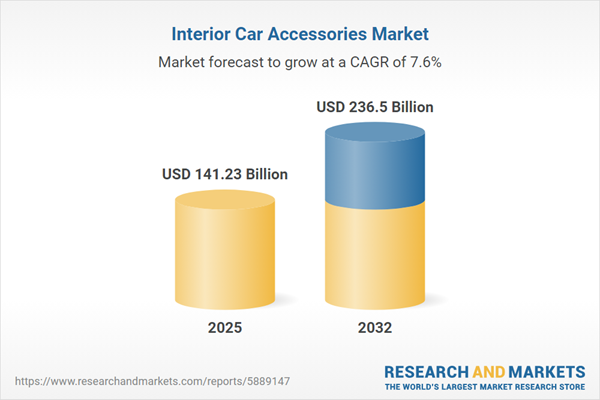Speak directly to the analyst to clarify any post sales queries you may have.
The interior car accessories market is entering a transformative period, shaped by dynamic consumer expectations and innovation in both digital and material technologies. Senior decision-makers require a concise, actionable analysis to understand the sector’s trajectory and prioritize investment for the evolving future of mobility and cabin experience.
Market Snapshot: Interior Car Accessories Market Size and Growth
The interior car accessories market grew from USD 131.39 billion in 2024 and is projected to reach USD 141.23 billion in 2025. With a compound annual growth rate (CAGR) of 7.62%, it is forecast to expand further, achieving USD 236.50 billion by 2032. This robust growth reflects heightened demand for comfort, personalization, and integrated digital features in vehicle interiors, driven by consumer lifestyle shifts and continual technological advancements.
Scope & Segmentation
This report offers comprehensive coverage of the primary keyword, examining extensive segmentation across products, vehicle types, channels, materials, and regions to inform high-level strategy formation for industry leaders. The scope includes:
- Product Types: Dashboard covers (PET felt, polypropylene), floor mats (fabric, PVC, rubber, thermoplastic elastomer), infotainment systems (headrest monitors, in-dash screens), interior lighting (ambient, LED, spotlights), seat covers (fabric, leather, synthetic leather), organizers (backseat, hanging, trunk), steering wheel covers (cloth, leather, PVC).
- Vehicle Classes: Heavy and light commercial vehicles, passenger cars (coupe, hatchback, sedan, SUV), motorcycles, and scooters.
- Sales Channels: Aftermarket, OEM.
- Distribution Channels: Auto parts stores, hypermarkets, specialty stores, OEM e-tailers, third-party e-commerce platforms.
- Material Types: Fabric, leather, plastic, rubber.
- Regions: North America (United States, Canada, Mexico), Latin America (Brazil, Argentina, Chile, Colombia, Peru), Europe (United Kingdom, Germany, France, Russia, Italy, Spain, Netherlands, Sweden, Poland, Switzerland), Middle East (UAE, Saudi Arabia, Qatar, Turkey, Israel), Africa (South Africa, Nigeria, Egypt, Kenya), and Asia-Pacific (China, India, Japan, Australia, South Korea, Indonesia, Thailand, Malaysia, Singapore, Taiwan).
- Covered Companies: Yanfeng Automotive Interiors, Adient, Forvia, Lear Corporation, Magna International, Visteon, Grupo Antolin, Toyota Boshoku, Hyundai Mobis, Motherson Sumi Systems.
Key Takeaways for Decision-Makers
- End-user focus on personalized and digitally connected interiors is redefining accessory design and portfolio priorities.
- Sustainability goals and evolving regulatory frameworks are accelerating the adoption of eco-friendly materials, supporting a competitive edge for early adopters.
- The convergence of smart technology with aftermarket and OEM offerings is enhancing the user experience and expanding monetization opportunities.
- Rapid shifts in consumer retail behavior are favoring omnichannel strategies that integrate physical and digital sales environments, improving engagement and conversion.
- Regional disparities call for tailored approaches—premium and bespoke solutions are sought in the Americas and Middle East, while cost efficiency and function are critical in emerging Asia-Pacific markets.
Tariff Impact: Adjusting to US Trade Policy Changes
New United States tariffs effective from 2025 create upstream cost pressures across interior accessory components such as plastics, electronics, and lighting. This regulatory shift is prompting businesses to re-evaluate supplier geographies, invest in risk modeling, and adopt flexible pricing and procurement strategies to maintain customer value and profitability. Investing in scenario planning and supplier diversification proves central to supply chain resiliency amid evolving trade landscapes.
Methodology & Data Sources
This report synthesizes extensive secondary research, industry publications, and regulatory filings. Primary research involved executive interviews and targeted surveys with stakeholders from procurement, supply chain, and executive management. Data triangulation and expert peer reviews reinforce analytical validity and ensure actionable insights for strategic planning in the interior car accessories sector.
Why This Report Matters: Actionable Value for Leaders
- Identifies core drivers influencing procurement, R&D, and go-to-market strategies in the interior car accessories market.
- Provides an in-depth review of regional dynamics, product and material trends, and channel innovations for more precise market positioning.
- Equips industry stakeholders to anticipate risks and leverage new opportunities emerging from technology integration, regulatory changes, and shifting consumer preferences.
Conclusion
This report delivers senior-level clarity on the evolving interior car accessories landscape, with guidance on market adaptation and value creation. Strategic emphasis on consumer experience, sustainable materials, and flexible channel strategies is critical for maintaining competitiveness and unlocking future growth.
Additional Product Information:
- Purchase of this report includes 1 year online access with quarterly updates.
- This report can be updated on request. Please contact our Customer Experience team using the Ask a Question widget on our website.
Table of Contents
3. Executive Summary
4. Market Overview
7. Cumulative Impact of Artificial Intelligence 2025
Companies Mentioned
The companies profiled in this Interior Car Accessories market report include:- Yanfeng Automotive Interiors Co., Ltd.
- Adient plc
- Forvia SA
- Lear Corporation
- Magna International Inc.
- Visteon Corporation
- Grupo Antolin S.A.
- Toyota Boshoku Corporation
- Hyundai Mobis Co., Ltd.
- Motherson Sumi Systems Limited
Table Information
| Report Attribute | Details |
|---|---|
| No. of Pages | 185 |
| Published | October 2025 |
| Forecast Period | 2025 - 2032 |
| Estimated Market Value ( USD | $ 141.23 Billion |
| Forecasted Market Value ( USD | $ 236.5 Billion |
| Compound Annual Growth Rate | 7.6% |
| Regions Covered | Global |
| No. of Companies Mentioned | 11 |









